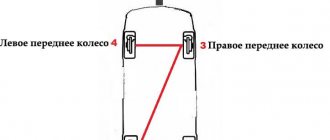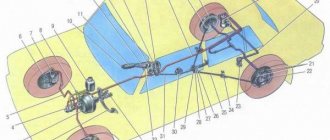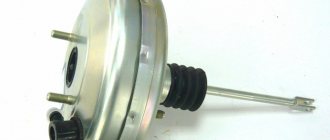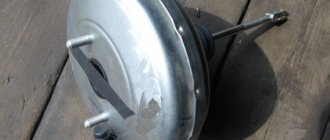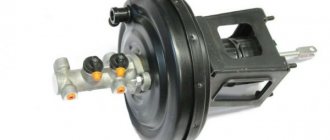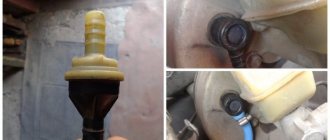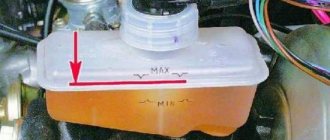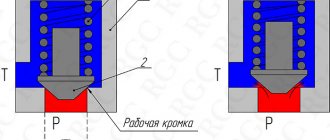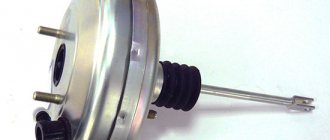A brake control element such as the brake pedal has several states of its position.
The first, which should be normal, is when the pedal is pressed without noticeable changes, without dips, jerks, without applying much effort, etc. The following two states of the pedal position are unpleasant for the driver and cause some concern.
We are talking about when your brake pedal becomes tight or, conversely, your brakes are too soft. In this state of affairs, when the brake pedal stops working in the normal, familiar mode, the driver’s concern is justified. This means that some malfunction has arisen and the brake system needs to be repaired. Without delay.
Why is your brake pedal tight?
There may be several reasons why the brake pedal suddenly becomes tight, and they may not necessarily be traditional and typical for all types and models of brakes. However, let's look at the main, most typical causes and methods for eliminating them.
In most faults that cause a soft brake pedal, either the vacuum booster or the brake master cylinder are to blame.
So, an increase in force when pressing the brake pedal occurs due to:
- The vacuum booster air filter is clogged. In this case, it is necessary to replace the air filter;
- The valve body in the vacuum booster is stuck. The solution is to replace the vacuum booster;
- The vacuum booster diaphragm is damaged. Change the vacuum booster;
- The tip of the vacuum booster is faulty - the tip needs to be replaced;
- the check valve in the vacuum booster is stuck or does not work, the check valve needs to be replaced;
- The check valve of the vacuum booster is faulty (leaky), which allows fuel to enter the cavity of the vacuum booster. It is necessary to change the vacuum booster assembly with the check valve;
- The hose connecting the vacuum booster to the intake manifold is damaged, or the hose fastening on the fitting is loosened. We change the hose or tighten the fastening clamp. Learn more about the brake booster hose. His condition must be monitored systematically. Especially during the cold season. As long as the hose is not warmed up, it remains quite rigid and the brakes work normally. After a short period of engine operation, the hose heats up, becomes more elastic, and if you do not notice its delamination, for example, its throughput decreases. There may be a problem with the brake pedal.
- The sealing rings in the working (wheel) cylinders are swollen. This can happen due to the ingress of fuel and lubricants into them, or the use of poor-quality brake fluid. Repair of working brake cylinders, replacement of brake fluid with that recommended by the manufacturer.
A couple of ways to check the performance of the vacuum booster
Start the engine. A vacuum is created in the system. Now press the brake. A hard brake pedal means a faulty booster or hose. After turning off the engine, wait about 5 minutes without pressing the brake.
Let's specify the problem. Step on the pedal. If the pedal is still hard, the vacuum booster valve is most likely faulty.
One more test. With the engine off, press the brake pedal several times to relieve the vacuum in the brake system. Without releasing the brake pedal, start the engine. If the pedal goes down slightly, then everything is fine with the amplifier.
Why are my brakes soft?
A soft brake pedal can indicate several problems. More precisely, there are several reasons why the brake pedal suddenly became soft. This effect can also be called: brake pedal failure.
Soft brakes have traditional causes:
- “airing” of the brake system. Naturally, air removal is required, i.e. bleeding the brake system. The cause of “airing” may be: depressurization of the system or low level of brake fluid in the expansion tank;
- Master brake cylinder malfunction:
- malfunction of the working cylinder, for example, as a result of jamming of the piston or boiling of the brake fluid. It is necessary to repair the brake cylinders or replace the brake fluid with new one.
Good luck to you in carrying out correct diagnostics and timely maintenance of the car’s brake system. After all, the brakes are our safety.
We recommend: Installing fog lights on Lada Kalina
Why is the pedal soft?
Due to certain problems, the brake pedal frog may also be faulty. Such a nuisance can come “in full” along with other related ones. Very often, a soft brake pedal is the direct cause of a significant deterioration in vehicle control.
A soft brake pedal may be a simple feature of the model. The cause of malfunctions may be air entering the relevant system. Everything is corrected by bleeding the brake itself in order to protect it from possible problems.
In turn, air can enter the system in many ways, and if problems appear with it, then most likely it is to blame. The pipeline may well lose its seal or even burst in this case. Due to a breakdown of the master cylinder, in which the brake fluid begins to boil, corresponding problems also arise. An accompanying failure is often jamming of the piston. It is advisable to diagnose the cylinders and check the brake fluid. It would also be a good idea to do a complete health check of the machine to determine if there are any hidden problems, if any.
The brake pedal fails (the brakes are too soft)
It is worth noting that if you feel weak braking when pressing the brake of a VAZ 2109 or any other model, you need to think about the fact that these may be features of a particular vehicle. Perhaps you just moved from another car, so you feel some discomfort while driving a new car.
On the other hand, such a symptom can also occur when air enters the system. It should be noted that in the event of depressurization of the system, the pipeline may completely burst and completely fail. This can be corrected by bleeding the brakes. At the same time, you should diagnose the cylinders, check the level of the brake fluid, as well as its quality (often air gets into the brake system simply because there is too little fluid) and perform a full check of the vehicle (the latter will help determine the presence of hidden problems) ;
If the pedal becomes soft after replacing the brake fluid, then, as a rule, the problem lies in the use of a low-quality mixture. Alternatively, it is possible that air got into the system during replacement - this is also worth paying attention to.
It is also quite common for the pedal to feel soft after bleeding the brakes. First of all, you should bleed the master cylinder. As a rule, this solves a similar problem. Alternatively, there may be problems with the anti-lock braking system (if equipped). In any case, if the brakes are soft after bleeding, you should approach this task responsibly. Perhaps you should contact specialists who can quickly and effectively fix the problem.
It will also be interesting: The starter takes over the current: what to do?
Video about the operating principle of the brake master cylinder:
Solution
If your car has such a breakdown, the main thing is to solve it comprehensively. It happens that malfunctions are associated with several reasons at once. If the problem is that the pedal is simply rusty, it needs to be replaced. It is easy to correct the situation by replacing the brake fluid with a higher quality one. By the way, you will have to update the fluid in any case - in order to “update” the entire system. Otherwise, over time, the pedal will definitely begin to fail when pressed.
If cracks appear in the pumps, the brake may also begin to fail. Moreover, even microdamages can be the cause of such a breakdown. So if you want the brake to function and not fail in the middle of the road, you will have to replace everything that has stopped working. It turned out to be enough for me to make one replacement. At this point, the question of why the brake pedal failed was closed. To be convinced, it was enough to just start the engine. No extraneous sounds. And if before the return after pressing was too slow, now everything works perfectly.
If the pedal is not pressed
The pedal force is facilitated by a vacuum booster.
The brake pedal is too tight - check the vacuum booster.
This means that if the pedal has become hard or is pressed too hard, the reason is related to it. This could be a simply disconnected or cracked rubber tube coming from the engine exhaust manifold. Or a breakdown of the device itself, most often associated with its depressurization.
In rare cases, breakage or disconnection of the levers may occur - this will be associated with characteristic sounds when pressing the pedal. Sometimes a foreign object or a bent part of the mat gets under the pedal.
Design of a standard brake system
Basic design of the brake system
- The brake pedal and the levers going from it to the amplifier.
- Vacuum booster (VA) - uses rarefied air from the engine to facilitate pedal operation.
- Master brake cylinder – evenly distributes the force received from the brake control unit to each wheel. Brake fluid is used to transmit pressure.
- Metal tubes and rubber hoses - through them, fluid is pumped from the master brake cylinder to the brake workers.
- Brake wheel cylinders and brake pads are installed on all four wheels and provide braking action to each brake disc or drum.
Malfunctions of the "vacuum"
A vacuum brake booster (VUT), or simply a “vacuum booster,” creates in the vehicle’s vehicle the pressure necessary for their proper operation.
If the amplifier is not working well, the pedal simply won't push through. Since the vacuum booster is a rather complex part consisting of many components, a malfunction of any of them can lead to this situation. And since a breakdown of an amplifier component, as a rule, requires its replacement, correct diagnostics will help save the car owner not only time, but also money.
If the filter element of the “vacuum tank” is clogged, it is enough to replace it so that the amplifier begins to function normally again. This also applies to a damaged vacuum booster diaphragm, and problems with the tip or check valve. It is enough to replace one damaged component, and the vehicle will act like new again. It is important to accurately diagnose what exactly needs to be changed.
Sometimes no major replacements are required at all. For example, in a situation where the vehicle is depressurized. The seal can be broken in two cases: either the hose between the “vacuum reservoir” and the intake manifold is damaged, or the clamps are loose. And if in the first case replacing the hose is still necessary, then in the second it is enough to tighten the clamps. This can also be done at a car service center, but the car owner is quite capable of dealing with such a problem on his own.
But it happens that the unsuitability of only one component completely renders the VUT unusable. This most likely occurs in a situation where vehicle malfunctions are ignored for a long time. As a result, a badly damaged valve moves to such a position that it disables the entire “vacuum tank”. An example is damage when a valve jams in the amplifier, and the latter has to be completely replaced. This is one of the most expensive types of vehicle repair.
We recommend: How to replace valve stem seals without removing the cylinder head?
Personal experience of car owners.
Alexei:
“I am a driver with little experience, so it was very difficult for me to independently determine the cause of the pedal hardness. I couldn’t even figure out how to remove this or that part in order to diagnose specific problems. In the end, I took my Audi A6 to a service station. The craftsmen working there determined the nature of the damage without even removing the units. Correct diagnostics helped me significantly save on repairs.”
Ivan:
“When the amplifier of my VAZ 2114 broke down, I verified that it was faulty in a simple way. To do this, the hose is removed and the amplifier is turned off. The presence of a vacuum when starting the engine indicates that the “vacuum valve” is faulty.”
Novel:
“The vacuum booster and cylinders are very difficult to diagnose. The best vehicle diagnostics can be provided only by those car services that have pressure gauges.”
Why does the brake pedal sink when the engine is running? Several Possible Reasons
The inability to make an emergency stop is a threat to everyone around you, so you need to find out immediately why the brake pedal falls while the engine is running. Even if the failure was a one-time failure, it cannot be ignored. System failure threatens disaster not only for you, but also for those nearby on the road. Despite the fact that any automaker pays the greatest attention to the brake system and tries to secure it from all sides, the inattention of the car owner and the natural development of mechanisms make the brakes more likely to fail quite high. And before leaving the parking lot or garage, you need to find out what caused the problems and fix them immediately. Why does the brake pedal sink when the engine is running? There may be several reasons. But the main and most common problem is air getting into the system (so-called airing). Moreover, the ways of its penetration may be different. Attention: brake fluid It is most often to blame for the failure of the corresponding pedal. Low level of brake fluid filling in the compensating tank. There is a mark on it indicating the minimum volume required for normal brake operation. If the fluid drops below the line, air enters the system, the pedal stops feeling resistance, and the car stops braking. It is advisable that the brake fluid does not drop to a minimum, since as the pads wear, the pistons push them deeper and deeper, therefore, more fluid is consumed. That is, at any moment it can fall below the required level. You need to check the amount of fluid regularly, even if the corresponding light does not give a signal. The next type of trouble that brake fluid can cause is the result of the negligence of the car owner himself. Filling brake fluid with the wrong class (for example, DOT3 instead of DOT 4) or mixing fluids from different manufacturers leads to corrosion of the cuffs and seals, clogging of the entire brake line or a section thereof. Boiling of the brake fluid leads to the fact that, if it corresponds to the class and the normal level in the reservoir, The pedal stops working right on the move. Everyone knows that overheating your brakes is unsafe. If it is not possible to avoid aggressive driving, especially in the summer heat, it is worth replacing the brake fluid with high-temperature fluid, and the brake discs with cooled and ventilated ones. When checking the level and condition of the brake fluid in case of pedal failure, all hoses, cuffs, gaskets and seals are simultaneously inspected : loss of tightness by the system is the second most likely reason for air from the atmosphere getting into it. Related article - “Where to fill and how to replace brake fluid.” Pads and discs Replacing both over time is required on any car. For some time after this, malfunctions in the operation of the brakes may be observed: vibration on the pedal can be felt, braking may occur jerkily. This is considered normal, since the new parts should get used to each other. But if failures remain even after 200-300 km after installing spare parts, this is already an alarming sign. It indicates improper installation during replacement. Can be:
- displacement of the vertical axis of the caliper relative to that of the brake disc. A deviation of literally 3-4 degrees is enough;
- poor caliper fixation.
So when replacing parts in the brake system, it is especially meticulous to check the alignment of the caliper with the disc. Otherwise, the block will be worn down to half, and by definition you will not have normal brakes. Vacuum brake booster A wonderful invention of mankind, designed to ease the effort during braking. But when the diaphragm wears out, it can cause a lot of thrills. Symptoms of problems with the amplifier are:
- The pedal clearly sinks, but the brake fluid, when the engine is running, remains at the same level;
- If the engine is turned off, the elasticity of the pedal remains normal;
- The situation is explained simply: the amplifier begins to operate only when the engine is running, so in a silent car it has no effect on the brakes. When the amplifier comes into play, due to a torn diaphragm, the required degree of vacuum in the chamber is not achieved, and the pedal goes to the floor.
We recommend: How to replace the instrument panel lamps on a Lada yourself?
Article on the topic: “How to check the vacuum brake booster.” However, before establishing the reasons why the brake pedal fails while the engine is running, you need to be able to stop the car, which becomes difficult - especially in heavy traffic and at speed. The main thing here is not to twitch or panic. If the transmission on the car is manual, you can stop the car simply with the engine, switching to a lower gear with a shift in the throttle. And there is always a working handbrake (which is also recommended to be checked from time to time), which can help out, even if the pedal has completely failed.
Is it possible to add brake fluid from another manufacturer or brand to the reservoir?
Going to buy 1 liter of TJ – it would seem that there’s nothing special about it. I came to the store, ordered, paid and went to the garage with a satisfied look. This was the case before, when out of all the auto chemical enterprises there was only one in the news - the Dzerzhinsky plant. Now you can not only easily confuse diesel and gasoline oil, but also the composition of the braking system. After all, in the market, even experts sometimes get their eyes wide open. Here you have Rosdot, and Sintec, and a bunch of other similar names.
What will an unscrupulous driver do? He’ll take any one and go with the idea of quickly resolving the issue. Motorists are rushing to warn against such indifference. The mixing operation is, of course, permissible, and the manufacturer even indicates with what compounds his product can be used. The question is whether it is possible to add brake fluid of another brand when the consumer is not aware of the origin of the emulsion already filled.
Undoubtedly, the code for the current composition can be found in the instruction manual. What if it is lost, or the car is bought secondhand? In general, if the situation is unclear, it is recommended to completely change the working fluid. What you definitely shouldn’t do is pour in TF with a low boiling point. Dangerous.
#1 Gladiator
Our locomotive fly forward!
Good afternoon. Now that I have time, I want to work on the brakes.
There is a pressing problem - low braking (slowdown) efficiency and a soft brake pedal.
Those. There seem to be brakes, but for a critical situation they are clearly too weak - I may not have time to stop. Those. I press the pedal (at least to the floor) and it slows down slowly. There is not even any talk about use.
By analogy with a bicycle - there are those in which you press on the pedal and the rear wheel is blocked until the black stripe on the asphalt, and on the other - you press - but you won’t stop quickly, there is no effective deceleration (that’s how it is for me).
1. The brakes are bled. True, the sorcerer did not stick a screwdriver into it, but he loaded the trunk with 100 kg.
2. The front cylinders were sour. I treated it a little with castor oil. When driving without braking, they do not jam, the discs are cold. When driving around the city, they work. After the trip, the discs are warm (the front right and rear left are hotter than the front left and rear right). The rear right disc is the coldest. When braking, the car does not go anywhere. There is no vibration.
3. GTZ costs Pilenga. The vacuum rod was not adjusted. If you stand at a traffic light and keep your foot on the brake, the pedal does not go down, i.e. The GTZ doesn't seem to let it through.
4. When the car is not started, it is impossible to pump up the brake pedal. Previously, after several pumping motions, its stroke became less and less and the pedal became stuck. Now this is not the case. True, if you start the engine with the pedal pressed, it goes down a little. Well, when pumping up the pedal, it hisses a little - it wheezes. True, when running, the engine speed does not change when swinging.
5. The brake hoses are new (Lukas), the brake fluid is fresh, there are no leaks anywhere.
Should I be concerned if the brake pedal is stiff or soft after bleeding?
The manufacturer has ensured that the brake pedal is pressed as easily and conveniently as possible. It is important that there is no need to exert significant effort while pressing, and various dips and jerks are unacceptable. Regardless of whether the brake pedal is soft and does not stop well, or there is a problem of some other kind, it is important not to leave things to chance. In general, if the brake pedal fails, then you urgently need to go to a service station or top up the brake fluid yourself. Most likely there is a leak in the brake system.
Both a tight pedal and too easy its movement are an alarming symptom that can indicate a number of serious problems.
Brake operation when the engine is off
The pressure on the pedal is related to the vacuum booster. And the VU itself can only work with the engine turned on. When parked for a long time, the pressure in the vacuum chamber becomes atmospheric - the amplifier does not work. When you press the pedal, the force is transmitted directly from the levers to the master cylinder. The resistance on the pedal increases by 3-5 times.
A hard brake pedal after parking is normal.
If you start the engine while holding down the pedal, it should fall slightly. You can go safely.
Monitoring the technical condition of a car is a conscious need for any driver who wants to ensure the safety of himself and others.
Vacuum booster diagnostics
Often, a sign of depressurization is unstable engine operation (tribbing). This happens due to air entering the intake manifold. It sharply depletes the air-fuel mixture entering the cylinders. If the pedal does not press when the car is running, first of all you should check the reliability of the connections
.
In addition, when the system depressurizes while the engine is running, a characteristic hissing sound is heard from the vacuum booster.
To pinpoint the problem, turn off the engine and wait a few minutes without pressing the pedal. If after this time the pedal remains hard, the most likely cause is a broken check valve.
It is very easy to diagnose the correct operation of the vacuum booster
. To do this, without starting the car, you should “pump” the pedal, then, continuing to hold it, start the engine. If the vacuum seal is working properly, the pedal will go down.
Swelling of rings in cylinders
The condition of the brakes largely depends on what kind of brake fluid is used during operation. If it is a product of a well-established company, the vehicle is rarely damaged or disabled. But if the fluid is of poor quality, one or more cylinders may not function well due to their O-rings swelling. The same thing happens when fuel and lubricant gets on the ring.
Previously, especially in the era of the Soviet automobile industry, the car owner sooner or later had to sort out the working cylinders. Such an activity was long and burdensome even for professionals. But now hardly anyone will do this if the vehicle is faulty. From the point of view of saving time, it is much easier to change them, and at the same time the brake fluid. However, you can avoid unnecessary financial costs if you use high-quality, albeit expensive, liquid from the very beginning, since repair costs are always higher.
Taking into account the above, it becomes clear that any deviations from the norm in the operation of the brake system (either a soft brake pedal, a hard brake pedal, or a combination of problems) require immediate diagnosis. After identifying the malfunction, it is necessary to properly eliminate the problem.
You also need to promptly change the fluid, bleed the brakes, inspect the brake hoses for defects and leaks, install new brake pads, discs or drums in a timely manner, lubricate the brake caliper guides, etc. This approach will allow you to safely operate the car and achieve high-quality performance of the braking system in any conditions.
